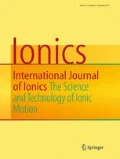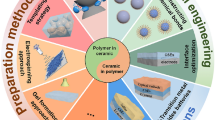Abstract
In order to develop new electrolytes for all-solid-state rocking chair lithium batteries, the NASICON-type compounds Li2FeZr(PO4)3 and Li2FeTi(PO4)3 were investigated by powder X-ray diffraction technique and impedance spectroscopy.
Li2FeZr(PO4)3 is orthorhombic Pbna (a=8.706(3), b=8.786(2), c=12.220(5) Å) and Li2FeTi(PO4)3 is orthorhombic Pbca (a=8.557(3), b=8.624(3), c=23.919(6) Å). They show no phase transitions from RT to 800 °C. In the same temperature range logσT vs. 1/T show no slope variations. The activation energies for the ionic conductivity were 0.62 and 0.64 eV for Li2FeTi(PO4)3 and Li2FeTi(PO4)3, respectively.
In order to better evaluate the present results they were compared with those of α and β-LiZr2(PO4)3 phases, which were also prepared and characterised.
A change of activation energy from 0.47 eV to 1.03 eV was observed in the case of β phase, at about 300 °C; attributed to the β (orthorhombic) ↔ β′ (monoclinic) phase transition. In the α phase the activation energy 0.47 eV in the temperature range 150 – 850 °C.
The Li2FeZr(PO4)3 and Li2FeTi(PO4)3 compounds can be interesting for applications as solid electrolytes in high temperature (>300 °C) lithium batteries.
Similar content being viewed by others
References
C. Julien, Solid State Batteries, in: The CRC Handbook of Solid State Electrochemistry, (P.J. Gellings, H.J.M. Bouwmeester, Eds.), CRC press, Boca Raton, USA, 1997, p. 371.
B. Scrosati, Rechargeable lithium cells, in: Modern Batteries, (C.A. Vincent and B. Scrosati, Eds.), Arnold, London, U.K., 1997, p. 198.
G. Adachi, N. Imanaka, H. Aono, Adv. Mater.,8(2), 127 (1996).
A.D. Robertson, A.R. West, A.G. Ritchie, Solid State Ionics,104, 1 (1997).
C.J. Brinker, G.W. Scherer, Film Formation, in: Sol Gel Science, Academic Press Inc., San Diego, USA, 1990, p. 787.
J.B. Goodenough, H.Y-P Hong, J.A. Kafalas, Mat. Res. Bull.11, 203 (1976).
R.D. Shannon, B.E. Taylor, A.D. English, T. Berzins, Electrochim. Acta22, 783 (1977).
M. Catti, and S. Stramare, Solid State Ionics, in press.
F. Sudreau, D. Petit, J.P. Boilot, J. Solid State Chem.83, 78 (1989).
M. Sugantha, U.V. Varadaraju, Solid State Ionics95, 201 (1997).
M. Catti, N. Morgante, and R.M. Ibberson, J. Solid State Chem. in press.
Author information
Authors and Affiliations
Rights and permissions
About this article
Cite this article
Ruffo, R., Mari, C.M. & Catti, M. Structural and electrical characterization of the NASICON-type Li2FeZr(PO4)3 and Li2FeTi(PO4)3 compounds. Ionics 7, 105–108 (2001). https://doi.org/10.1007/BF02375475
Received:
Revised:
Accepted:
Issue Date:
DOI: https://doi.org/10.1007/BF02375475




